
Here you can study for the exam. Look up keywords and learn definitions about all kind of subjects.
More subjects
The Abyssinian /æbɪˈsɪniən/ is a breed of domestic short-haired cat with a distinctive 'ticked' tabby coat, in which individual hairs are banded with different colors. They are also known simply as Abys. The source of the name is not because Ethiopia, formerly Abyssinia, is thought to be the original home of these cats, but because the first 'Abyssinians' exhibited in shows in England were reported to have been imported to England from there. Its true origin — according to genetic studies — is likely to have been the coast of the Indian Ocean in parts of Southeast Asia, and its introduction to Abyssinia (and others) was through colonialists and merchants stopping through Calcutta. (Source: Wikipedia.org, CC BY-SA)
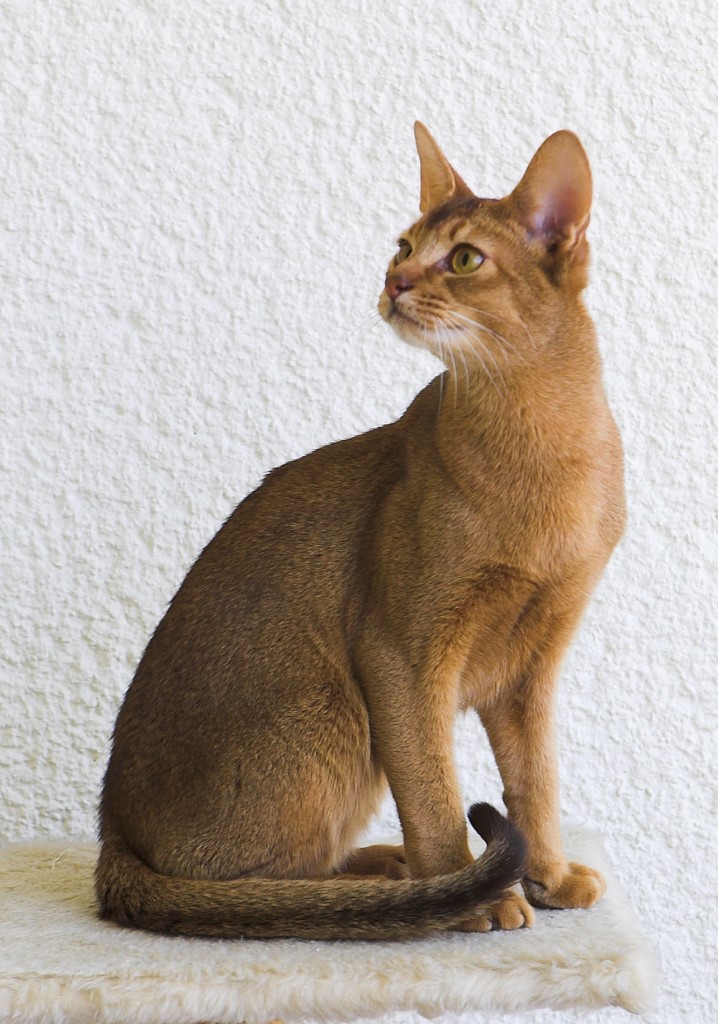 © Wikimedia.org/Karin Langner-Bahmann, CC BY-SA
© Wikimedia.org/Karin Langner-Bahmann, CC BY-SA
Aegean cats (Greek: γάτα του Αιγαίου gáta tou Aigaíou) are a naturally occurring landrace of domestic cat originating from the Cycladic Islands of Greece and western Turkey. It is considered a natural cat, developing without human interference. Development of the Aegean cat as a formal breed began in the early 1990s by breeders in the fledgling Greek cat fancy, but the variety has yet to be recognized by any major fancier and breeder organization. It is considered to be the only native Greek variety of cat. (Source: Wikipedia.org, CC BY-SA)
The American Bobtail is an uncommon breed of domestic cat which was developed in the late 1960s. It is most notable for its stubby 'bobbed' tail about one-third to one-half the length of a normal cat's tail. This is the result of a cat body type genetic mutation affecting the tail development, similar to that of a Manx cat. The breed is not related to the Japanese Bobtail despite the similar name and physical type—the breeding programs are entirely unrelated, and the genetic mutation causing the bobbed tail are known to be different because the mutation causing the American Bobtail's tail is dominant, whereas the Japanese Bobtail tail mutation is recessive. (Source: Wikipedia.org, CC BY-SA)
The American Curl is a breed of cat characterized by its unusual ears, which curl back from the face toward the center of the back of the skull. The breed originated in Lakewood, California, as the result of a spontaneous mutation. Due to its large genetic pool with non-pedigree cats, the American Curl is generally a healthy breed. However, their ears should be handled carefully, as rough handling may damage the cartilage in the ear, and require frequent cleaning to prevent infections. (Source: Wikipedia.org, CC BY-SA)
The American Shorthair (ASH) is a breed of domestic cat believed to be descended from European cats brought to North America by early settlers to protect valuable cargo from mice and rats. According to the Cat Fanciers' Association, in 2020, it was the eighth most popular pedigreed cat in the world. (Source: Wikipedia.org, CC BY-SA)
The American Wirehair is a breed of domestic cat originating in upstate New York. As of 2017, though the breed is well-known, it is ranked as the most rare of the 41 Cat Fanciers' Association breeds. (Source: Wikipedia.org, CC BY-SA)
The Arabian Mau is a formal breed of domestic cat, originated from the early African wildcat, a short-haired landrace native to the Arabian Peninsula. It lives in the streets of the Arabian Peninsula and has adapted very well to its extreme climate. The Arabian Mau is recognized as a formal breed by few fancier and breeder organization and cat registry, World Cat Federation (WCF) and Emirates Feline Federation (EFF). Based on one landrace, the Arabian Mau is a natural breed. It is medium in size, with a body structure that is rather large and firm, not particularly slender, and with well-developed musculature. The legs are comparatively long, with oval paws. (Source: Wikipedia.org, CC BY-SA)
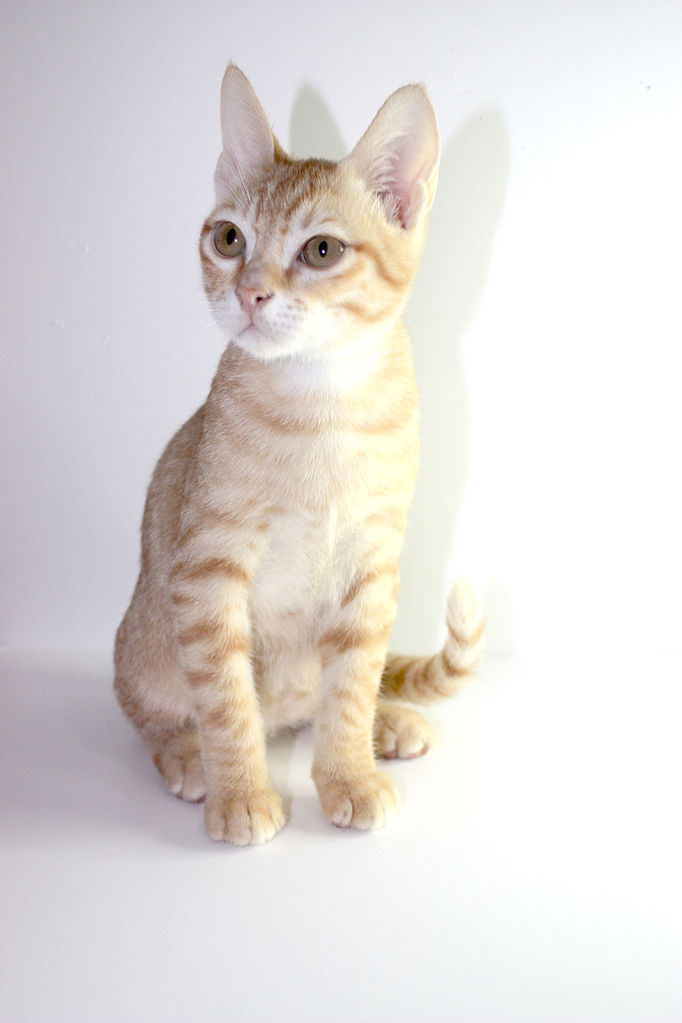 © Wikimedia.org/SolnishkoA, CC BY-SA
© Wikimedia.org/SolnishkoA, CC BY-SA
The Asian, also known as the Malayan, is a cat breed similar to the Burmese but in a range of different coat colours and patterns. Long-haired Asians of all varieties are called Tiffanies. Asians are grouped in the foreign section at cat shows. (Source: Wikipedia.org, CC BY-SA)
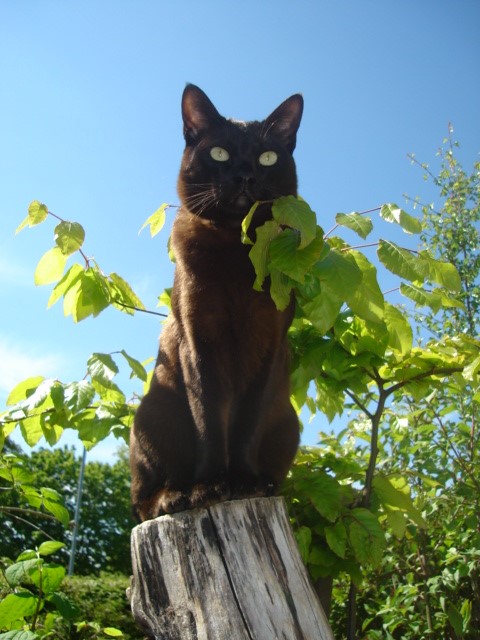 © Wikimedia.org/Scotia, CC BY-SA
© Wikimedia.org/Scotia, CC BY-SA
The Asian Semi-Longhair is a cat breed similar to the Asian Shorthair except it has semi-long fur. The breed is also known by the name Tiffanie. It is recognized in any of the Asian Shorthair or Burmese colors and patterns. Like the Asian Shorthair, the breed was developed in Asia and is not currently recognized by any U.S. Registries. It has full recognition in the GCCF. It is related to, and in some registries distinct from, the Chantilly-Tiffany or Foreign Longhair, the North American variant. (Source: Wikipedia.org, CC BY-SA)
The Australian Mist (formerly female otherer Spotted Mist) is a breed of cat developed in Australia. It is a cross between the Abyssinian cat, the Burmese cat and Australian Tabby cat. Australian Mists are medium-sized short-haired cats, with a round heads and large eyes. The coat is very short and lacks an undercoat. The coat patterns have three aspects: the ground color, which is paler than the pattern; the pattern; and the appearance of wearing a misted veil, caused by random ticking in color solid color areas. The legs and tail are ringed or barred, and the face and neck also have lines of color. Their life expectancy is 15–18 years. (Source: Wikipedia.org, CC BY-SA)
The Balinese is a long-haired breed of domestic cat with Siamese-style point coloration and sapphire-blue eyes. The Balinese is also known as the purebred long-haired Siamese, since it originated as a natural mutation of that breed and hence is essentially the same cat but with a medium-length silky coat and a distinctively plumed tail. As is the case with their short-haired counterparts, a genetic distinction is made between traditional or 'old-style' and modern body types. In the American standard, color variants derived from the Colorpoint Shorthair are further considered a separate breed, known as the Javanese. There is no particular connection between these cats and the Indonesian islands of Bali and Java, from which they derive their names. (Source: Wikipedia.org, CC BY-SA)
The Bengal cat is a domesticated cat breed created from a hybrid of the Asian leopard cat (Prionailurus bengalensis), with domestic cats, especially the spotted Egyptian Mau. The breed name comes from the leopard cat's taxonomic name. Bengals have a wild appearance; their golden shimmer comes from their leopard cat ancestry, and their coats may show spots, rosettes, arrowhead markings, or marbling. They are an energetic breed which needs much exercise and play. (Source: Wikipedia.org, CC BY-SA)
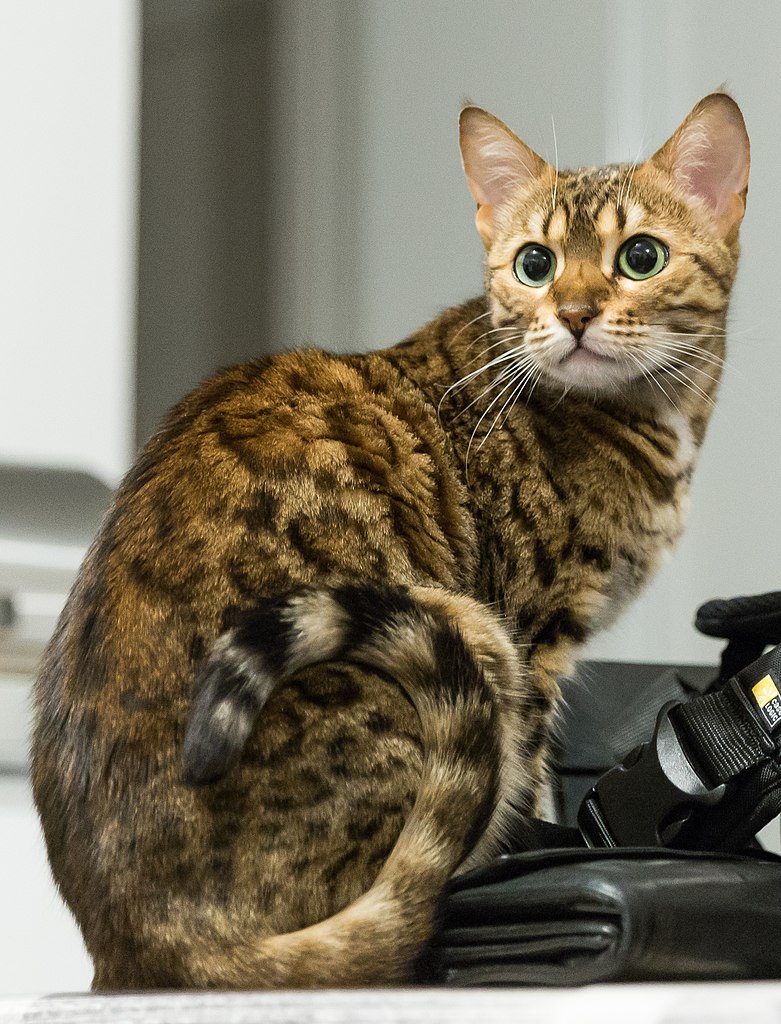 © Wikimedia.org/William Crochot, CC BY-SA
© Wikimedia.org/William Crochot, CC BY-SA
The Birman, also called the 'Sacred Cat of Burma', is a domestic cat breed. The Birman is a long-haired, colour-pointed cat distinguished by a silky coat, deep blue eyes, and contrasting white 'gloves' on each paw. The breed name is derived from Birmanie, the French form of Burma. The Birman breed was first recognized in France by the Cat Club de France in 1925, then in England by the Governing Council of the Cat Fancy (GCCF) in 1966 and in United States by the Cat Fanciers' Association (CFA) in 1967. It is also recognized by the Canadian Cat Association (CCA) and the International Cat Association (TICA) in 1979. (Source: Wikipedia.org, CC BY-SA)
The bobcat (Lynx rufus), also known as the red lynx, is a medium-sized cat native to North America. It ranges from southern Canada through most of the contiguous United States to Oaxaca in Mexico. It is listed as Least Concern on the IUCN Red List since 2002, due to its wide distribution and large population. Although it has been hunted extensively both for sport and fur, populations have proven stable, though declining in some areas. It has distinctive black bars on its forelegs and a black-tipped, stubby (or 'bobbed') tail, from which it derives its name. It reaches a total length (including the tail) of up to 125 cm (50 in). It is an adaptable predator inhabiting wooded areas, semidesert, urban edge, forest edge, and swampland environments. It remains in some of its original range, but populations are vulnerable to extirpation by coyotes and domestic animals. Though the bobcat prefers rabbits and hares, it hunts insects, chickens, geese and other birds, small rodents, and deer. Prey selection depends on location and habitat, season, and abundance. Like most cats, the bobcat is territorial and largely solitary, although with some overlap in home ranges. It uses several methods to mark its territorial boundaries, including claw marks and deposits of urine or feces. The bobcat breeds from winter into spring and has a gestation period of about two months. (Source: Wikipedia.org, CC BY-SA)
The Bombay cat is a type of short-haired cat developed by breeding sable Burmese and black American Shorthair cats, to produce a cat of mostly Burmese type, but with a sleek, panther-like black coat. Bombay is the name given to black cats of the Asian group. The Bombay is a short-haired breed of domestic cat, closely related to the Burmese. Bombay cats are typically characterized as having an all-black coat, black soles, black nose and mouth, with copper or green eyes. The close-lying, sleek and glossy black coat is generally colored to the roots, with little or no paling. (Source: Wikipedia.org, CC BY-SA)
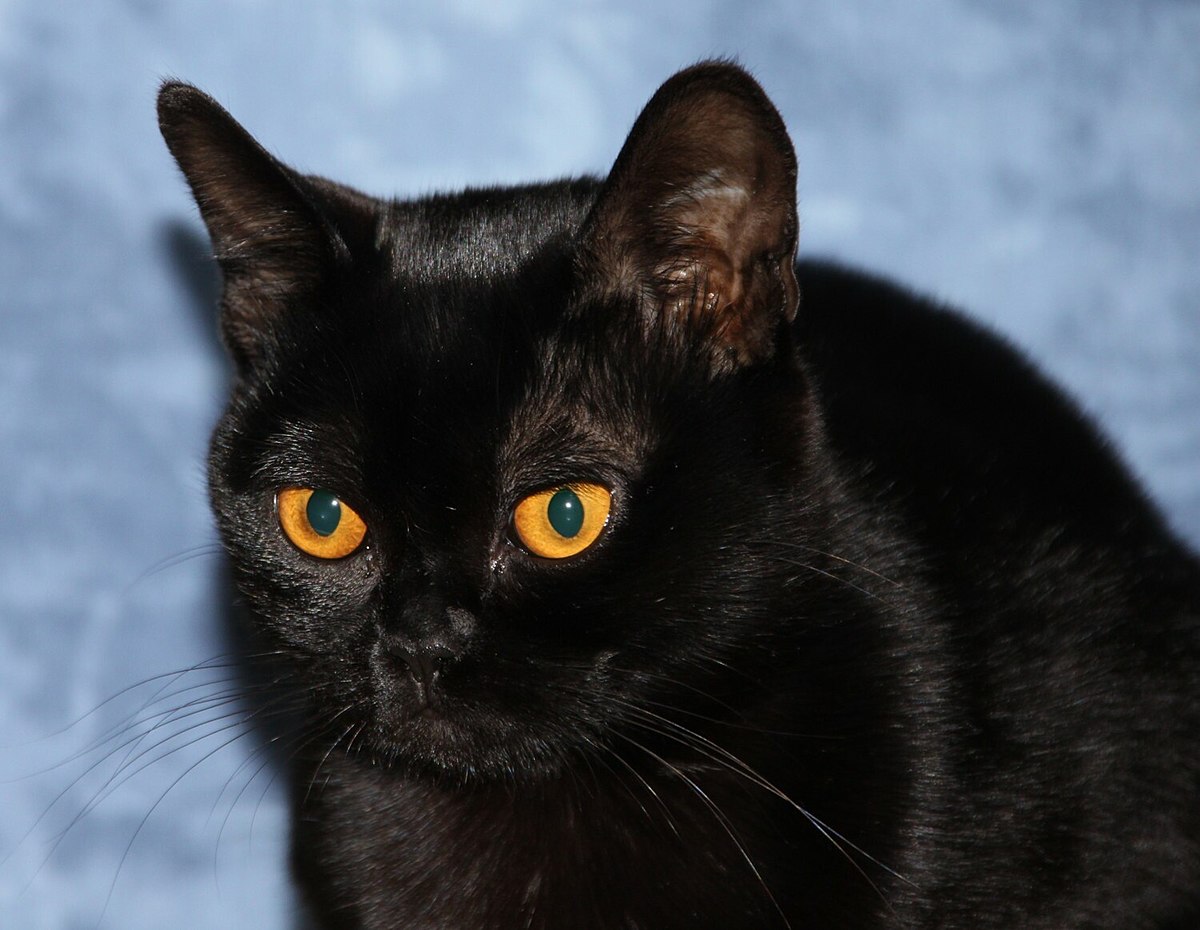 © Wikimedia.org/Bombaycats, CC BY-SA
© Wikimedia.org/Bombaycats, CC BY-SA
The Brazilian Shorthair is a medium-sized cat of great agility. The breed can be distinguished from the American Shorthair by its sleek and elegant appearance, though cats of the breed are not as thin as the Siamese. The coat is short and close to the skin and comes in a wide variety of colors and patterns. The space between the eyes should be equal to the size of one eye. Brazilian Shorthairs have dramatically expressive eyes. They are longer than they are tall. Males have bigger heads than females. (Source: Wikipedia.org, CC BY-SA)
 © Wikimedia.org/ Zombymania, CC BY-SA
© Wikimedia.org/ Zombymania, CC BY-SA
The British Longhair is a medium-sized, semi-long-haired breed of domestic cat, originating in Great Britain. British Longhairs can be prone to obesity if neutered or kept as indoor-only cats. Like most longer-haired cats, they require brushing or are prone to matting. Autumn and winter are the seasons when they have the highest risk of tangles because their coat thickens in preparation for winter. (Source: Wikipedia.org, CC BY-SA)
The British Shorthair is the pedigreed version of the traditional British domestic cat, with a distinctively stocky body, dense coat, and broad face. The most familiar colour variant is the 'British Blue', with a solid grey-blue coat, orange eyes, and a medium-sized tail. The breed has also been developed in a wide range of other colours and patterns, including tabby and colourpoint. It is one of the most ancient cat breeds known. In modern times, it remains the most popular pedigreed breed in its native country, as registered by the UK's Governing Council of the Cat Fancy (GCCF). A quarter of all kittens registered with the GCCF each year are British Shorthairs, making the British the most popular pedigree cat in the UK. (Source: Wikipedia.org, CC BY-SA)
The Burmese cat (Burmese: ဗမာကြောင်, Băma kyaung, Thai: ทองแดง or ศุภลักษณ์, RTGS: Thongdaeng or Supphalak, meaning copper colour) is a breed of domestic cat, originating in Burma, believed to have its roots near the Thai-Burma border and developed in the United States and Britain. Most modern Burmese are descendants of one female cat called Wong Mau, which was brought from Burma to America in 1930 and bred with American Siamese. From there, American and British breeders developed distinctly different Burmese breed standards, which is unusual among pedigreed domestic cats. Most modern cat registries do not formally recognize the two as separate breeds, but those that do refer to the British type as the European Burmese. (Source: Wikipedia.org, CC BY-SA)
The Burmilla is a breed of domestic cat that originated in the United Kingdom in 1981. It is a cross between the Chinchilla Persian and Burmese cats. Standards were produced in 1984, and the breed gained championship status in the United Kingdom in the 1990s. The Burmilla was born in the United Kingdom. Two cats, a Chinchilla Persian named Sanquist and a Brown Tortie Burmese named Fabergé, were both awaiting a partner in different rooms. One night, the cleaner left the door open. The two cats mated, producing four kittens born in 1981; also birthing a new breed. (Source: Wikipedia.org, CC BY-SA)
The California Spangled is a breed of domestic cat that was bred to resemble spotted wild cats, like the ocelot and leopard. They were usually expensive, priced between US$800 and $2,500. The popularity of two other spotted cats breeds, the Ocicat and the Bengal, overshadowed their development. Inspired by the poaching death of a leopard, the anthropologist Louis Leakey motivated Paul Arnold Casey, Jr. of California to breed a domestic cat resembling a small leopard in order to emphasize how important it was to preserve the leopard. (Source: Wikipedia.org, CC BY-SA)
 © Wikimedia.org/Flamingice007sg, CC0
© Wikimedia.org/Flamingice007sg, CC0
The Chantilly-Tiffany or Chantilly/Tiffany, also known as the Chantilly or the Foreign Longhair, is a breed of domestic cat which originated in North America. The Chantilly was thought to be extinct but later rediscovered in 1960. The Chantilly-Tiffany has a semi-foreign body style and a full semi-long coat. The coat is silky, soft and smooth; the lack of undercoat usually makes grooming simpler than that of cats with an undercoat. The Chantilly-Tiffany is slow to mature and usually does not come into its full stature until about two years old. The eye color of the feline intensifies with age. The head should be a broad, modified wedge with gentle curves. It should have a medium length nose and a strong, broad, short, softly squared muzzle and defined but not obvious whisker pads. (Source: Wikipedia.org, CC BY-SA)
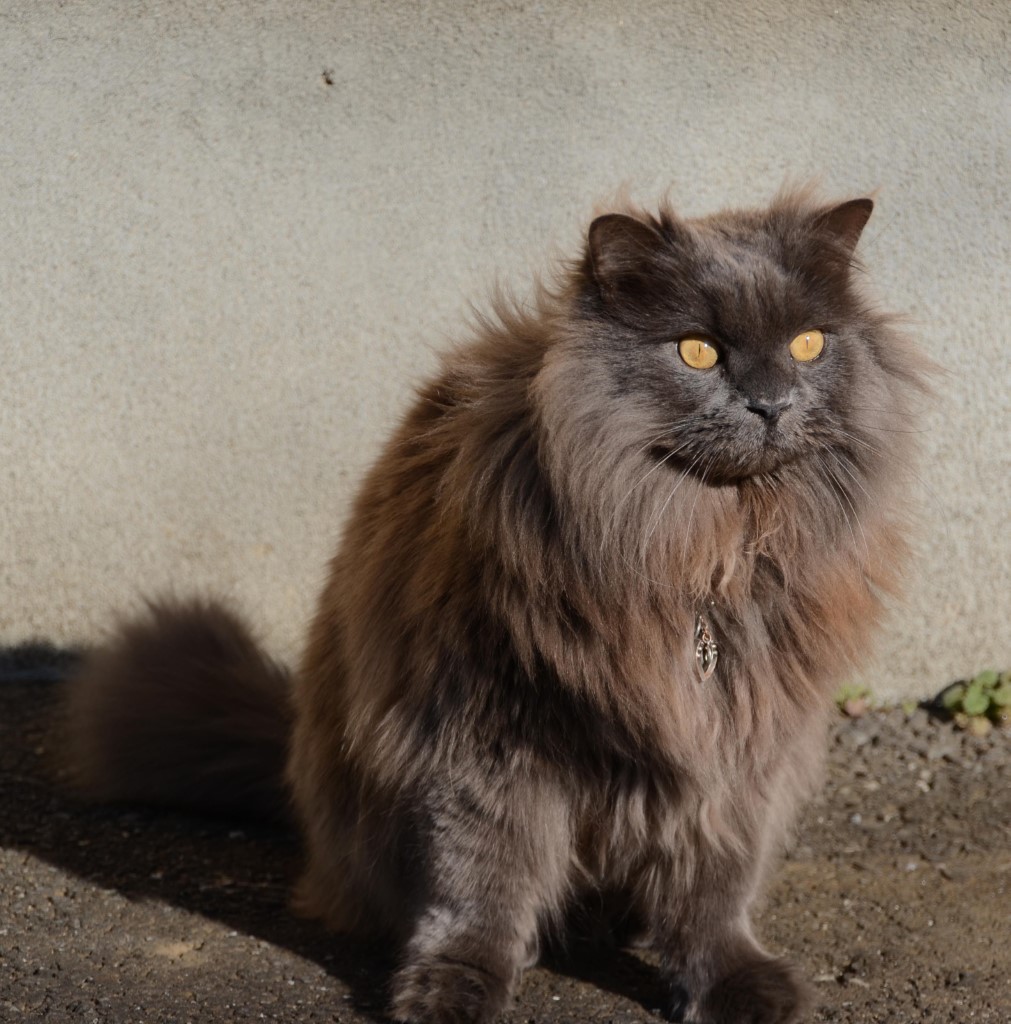 © Wikimedia.org/Jennie Kondo, CC BY-SA
© Wikimedia.org/Jennie Kondo, CC BY-SA
The Chartreux is a rare breed of cat from France, and is recognised by a number of registries around the world. The Chartreux is large and muscular (called cobby) with relatively short, fine-boned limbs, and very fast reflexes. They are known for their blue (silver-grey) water-resistant short hair double coats which are often slightly thick in texture (often showing 'breaks' like a sheepskin) and orange or copper-coloured eyes. Chartreux cats are also known for their 'smile'; due to the structure of their heads and their tapered muzzles, they often appear to be smiling. Chartreux are exceptional hunters and are highly prized by farmers. (Source: Wikipedia.org, CC BY-SA)
The Chausie (/ˈtʃaʊsi/) is a domestic breed of cat that was developed by breeding a few individuals from the non-domestic species jungle cat (Felis chaus) to a far greater number of domestic cats (Felis catus). The Chausie was first recognized as a domestic breed by The International Cat Association (TICA) in 1995. Within the domestic breeds, the Chausie is categorized as a non-domestic hybrid source breed. Because Chausies are mostly descended from domestic cats, by about the fourth generation they are fully fertile and completely domestic in temperament. (Source: Wikipedia.org, CC BY-SA)
Colorpoint Shorthairs are a variety of domestic cats. Depending on the cat registry, they may be considered a separate breed of cat, or more often a variant of a pre-existing one, if accepted at all. These cats are distinguished by their conformance to wide range of sixteen different point colors, beyond the four standard Siamese colors. The variety was initially created by crossbreeding Siamese with the American Shorthair – the same mixture that created the Oriental Shorthair, but with different goals. The Colorpoint Shorthair shares the point-coloration pattern with the Siamese, but in the nontraditional colors of red, cream, tortoiseshell, and lynx (tabby) points, and minor variations thereof. In body style, head shape, and other features, it may be intermediate between the two foundation breeds, which show cats leaning toward Siamese traits. Those who favour the Traditional Siamese look may also favour the more moderate-typed Colorpoint Shorthairs that take after their American Shorthair ancestors in shape. (Source: Wikipedia.org, CC BY-SA)
The Cornish Rex is a breed of domestic cat. The Cornish Rex has no hair except for down. Most breeds of cat have three different types of hair in their coats: the outer fur or 'guard hairs', a middle layer called the 'awn hair'; and the down hair or undercoat, which is very fine and about 1 cm long. Cornish Rexes only have the undercoat. They are prone to hair loss and many will develop a very thin coat or even go bald over large parts of their body. The curl in their fur is caused by a different mutation and gene than that of the Devon Rex. The breed originated in Cornwall, Great Britain. (Source: Wikipedia.org, CC BY-SA)
The Scottish Fold is a breed of domestic cat with a natural dominant gene mutation that affects cartilage throughout the body, causing the ears to 'fold', bending forward and down towards the front of the head, which gives the cat what is often described as an 'owl-like' appearance. Originally called lop-eared or lops after the lop-eared rabbit, Scottish Fold became the breed's name in 1966. Depending on registries, longhaired Scottish Folds are varyingly known as Highland Fold, Scottish Fold Longhair, Longhair Fold and Coupari. (Source: Wikipedia.org, CC BY-SA)
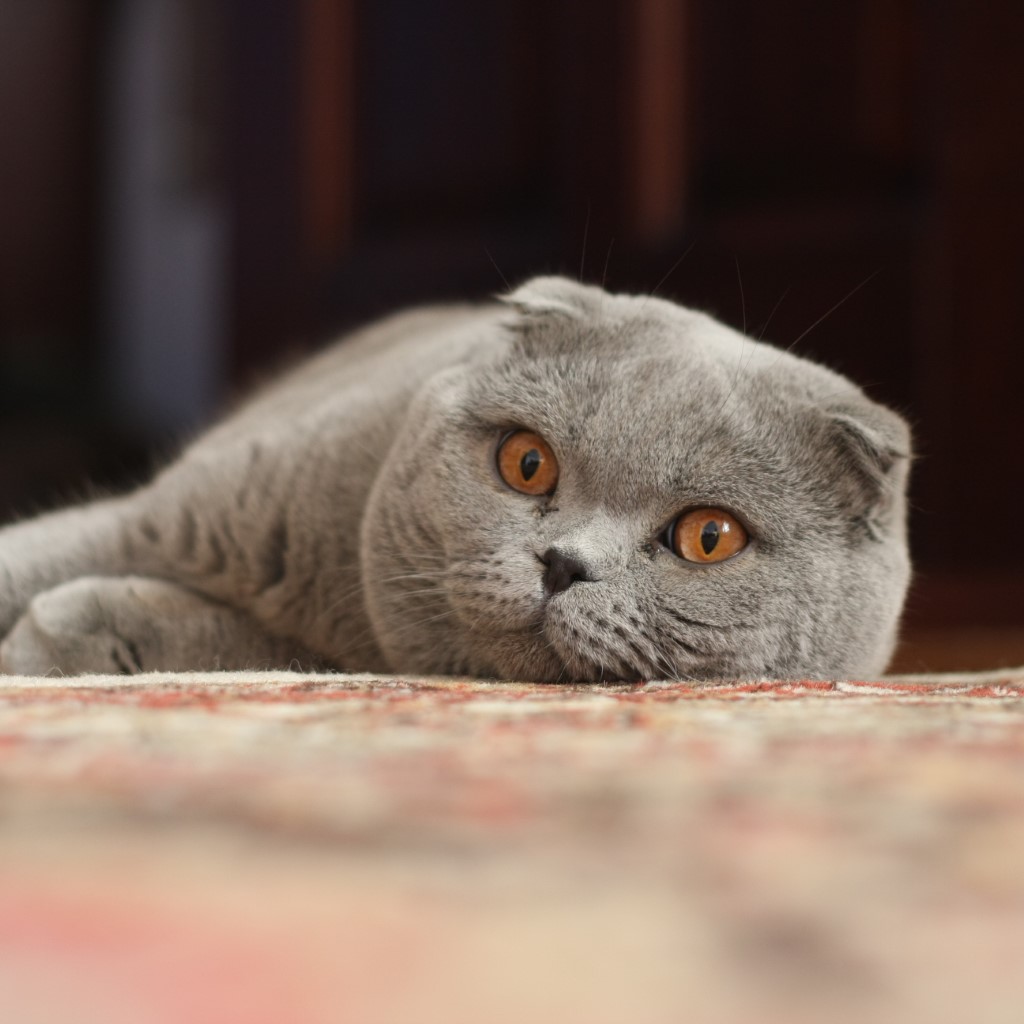 © Wikimedia.org/Mihai Matei, CC BY-SA
© Wikimedia.org/Mihai Matei, CC BY-SA
The Cymric (/ˈkɪmrɪk/ KIM-rik, /ˈkʌmrɪk/ KUM-rik) is a breed of domestic cat. Some cat registries consider the Cymric simply a semi-long-haired variety of the Manx breed, rather than a separate breed. Except for the length of fur, in all other respects the two varieties are the same, and kittens of either sort may appear in the same litter. The name comes from Cymru (Welsh pronunciation: [ˈkəmrɨ]), the indigenous Welsh name of Wales, though the breed is not associated with Wales, and the name was possibly given as an attempt to provide a 'Celtic'-sounding name for the breed. The breed's Manx bloodline originated in the Isle of Man, though Canada claims to have developed the long-haired variant. The breed is called the Longhair Manx or a similar name by some registries. (Source: Wikipedia.org, CC BY-SA)
Cyprus cats, also known as Cypriot cats, Saint Helen cats, and Saint Nicholas cats, are a landrace of domestic cat found across the island of Cyprus. A standardized breed is being developed from them; among cat fancier and breeder organizations, it is presently fully recognized by the World Cat Federation (WCF), with breeding regulated by the World Cat Congress (WCC), under the name Aphrodite's Giant; and provisionally by The International Cat Association (TICA) as the Aphrodite. All three organizations permit shorthaired and semi-longhaired versions and no out-crossing to other breeds. (Source: Wikipedia.org, CC BY-SA)
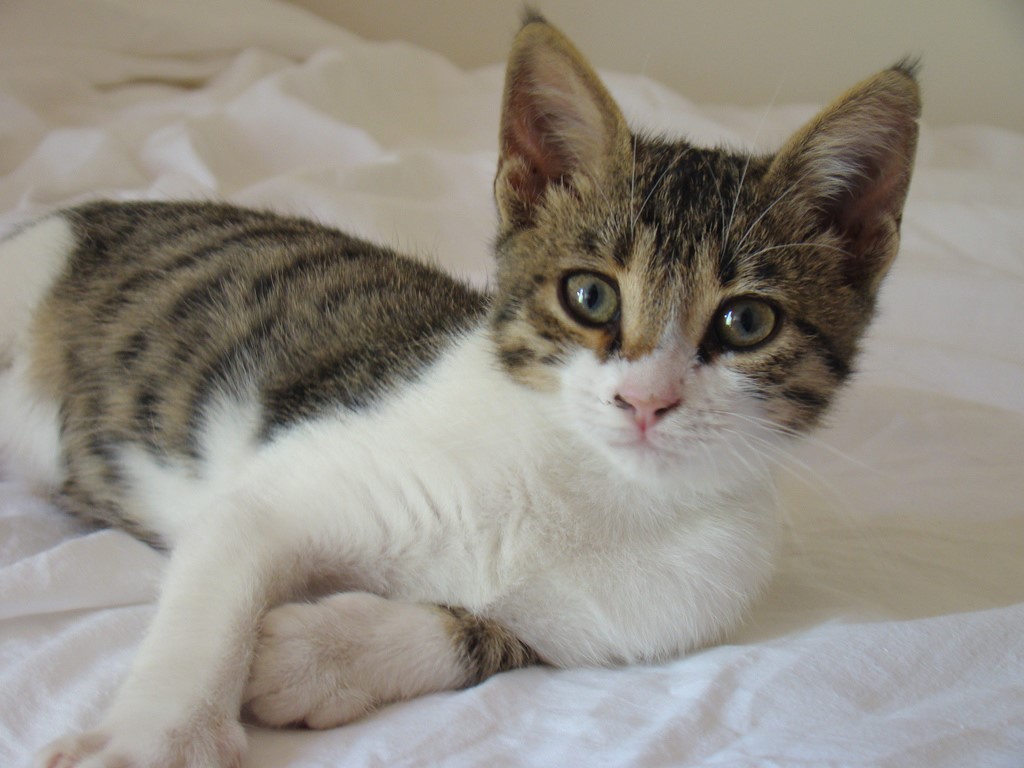 © Wikimedia.org/Riannacone, CC BY-SA
© Wikimedia.org/Riannacone, CC BY-SA
The Devon Rex is a tall-eared, short-haired breed of cat that emerged in England during the late 1950s. They are known for their slender bodies, wavy coat, and large ears. This breed of cat is capable of learning difficult tricks but can be hard to motivate. The typical Devon is active, mischievous, playful, and very people-oriented. They have been described as a cross between a cat, a dog and a monkey (or, more famously, as 'a monkey in a cat suit'). They are high-jumpers and will try to occupy any space large enough to admit them. With this trait, they are often found in odd nooks and crannies of a closet, shelf, or laundry basket. (Source: Wikipedia.org, CC BY-SA)
 © Wikimedia.org/Dobiasz, CC BY-SA
© Wikimedia.org/Dobiasz, CC BY-SA
The Donskoy cat, also known as Don Sphynx or Russian Hairless, is a hairless cat breed of Russian origin. It is not related to the better-known Sphynx cat, also known as the Canadian Hairless, whose characteristic hairlessness is caused by a recessive mutation in the keratin 71 gene. The Donskoy's hairlessness, on the other hand, is caused by a dominant mutation. This breed started in 1987 with the discovery of a hairless cat in the Russian city of Rostov-on-Don by cat breeder Elena Kovaleva. She had rescued a blue tortoiseshell kitten, which she named Varvara. At around four months of age, the cat began to lose fur. Varvara mated with a local tomcat and produced a litter of kittens; these kittens are the founding stock of the Donskoy breed and were later outcrossed with European Shorthair cats. (Source: Wikipedia.org, CC BY-SA)
The Dragon Li is a recently established Chinese breed of domestic cat (also called Chinese Li Hua or China Li Hua as a standardized breed, depending on breed registry). It was developed from a common landrace of cats in China, known as 貍花貓, Pinyin: líhuā māo, literally 'fox flower cat' (sometimes shortened to 花貓 huā māo or 貍貓 lí māo); the native cats are featured in some Chinese folklore stories. The Dragon Li displays a unique golden-brown, broken-mackerel (also known as broken-striped) tabby pattern; distinctive ear tipping; large round almond shaped luminescent yellow/green eyes; and a strong full bodied stature reminiscent of its wild nature. (Source: Wikipedia.org, CC BY-SA)
Egyptian Maus are a small to medium-sized short-haired cat breed. They are one of the few naturally spotted breeds of domesticated cat. The spots of the Mau occur on only the tips of the hairs of its coat. It is considered a rare breed. Egyptian Maus are considered by proponents to be one of the progenitor breeds of the modern domestic cat. The breed conformation is described as 'a balance between the compactness of a Burmese and the slim elegance of a Siamese. Its medium-length body is muscular, with the hind legs longer than the front, giving the Mau the appearance of standing on tiptoes when upright.' (Source: Wikipedia.org, CC BY-SA)
The European Shorthair, called the European in FIFe and WCF, is a cat breed originating in Sweden. The term has also been used as an elaborate way of referring to common domestic cats of Europe, causing some confusion as the pedigree cats of this breed also should resemble the typical domestic cats of Europe. In WCF a similar breed is known as Celtic Shorthair and was at a time considered the same breed, but this breed has some difference from the Europeans, and the WCF now register true Europeans under this breed name instead of under Celtic Shorthair. (Source: Wikipedia.org, CC BY-SA)
The Exotic Shorthair is a breed of cat developed as a short-haired version of the Persian. The Exotic is similar to the Persian in many ways, including temperament and conformation, a flat nose and face with the exceptions of the short dense coat. Exotic Shorthairs have a gentle and calm personality reminiscent of the Persian, but are generally livelier than their longhaired ancestors. Curious and playful, they are friendly to other cats and dogs, but they don't like being left alone and need the presence of their owner. They tend to show more affection and loyalty than most breeds and make excellent lap cats. Their calm, steady nature makes them ideal apartment cats for city dwellers. Nonetheless, Exotics retain some of the energetic spark of the American Shorthair, and they are often capable mouse hunters. (Source: Wikipedia.org, CC BY-SA)
The Foldex cat, also known as the Exotic Fold, is a breed of cat developed in the Canadian province of Quebec. Currently, the breed is recognized by only one cat registry, the Canadian Cat Association. Foldexes are medium-sized cats with a rounded face, short legs, and folded ears. The latter are the defining feature of the breed. Their eyes are well-rounded and wide open, with pair of ears with small and smooth-edged tips. They are described as intelligent and sweet.[citation needed] They were first registered as New Breed by the Canadian Cat Association in 2006 and then finally granted the Championship status in 2010. (Source: Wikipedia.org, CC BY-SA)
The German Rex is a medium-sized breed with slender legs of a medium length. The head is round with well-developed cheeks and large, open ears. The eyes are of medium size in colours related to the coat colour. The coat is silky and short with a tendency to curl. The whiskers also curl, though less strongly than in the Cornish Rex. They may be nearly straight. All colours of coat, including white, are allowed. The body development is heavier than in the Cornish Rex - more like the European Shorthairs. A German Rex cat is very friendly and quickly bonds with its human. It is lively, playful, and intelligent. Its temperament is much the same as a Cornish Rex. (Source: Wikipedia.org, CC BY-SA)
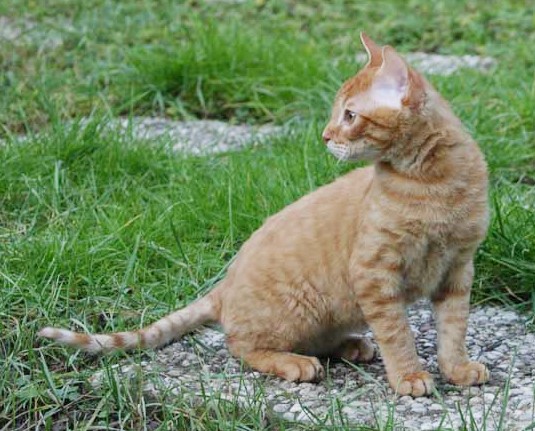 © Wikimedia.org/Bebopscrx, CC BY-SA
© Wikimedia.org/Bebopscrx, CC BY-SA
The Havana Brown was the result of a planned breeding between Siamese and domestic black cats, by a group of cat fanciers in England, in the 1950s. Early breeders introduced a Siamese type Russian Blue into their breeding. However, using current genetic testing, it is believed that almost none remain in the gene pool. It has been documented that self-brown cats were shown in Europe in the 1890s, one name given to these was the Swiss Mountain Cat. These disappeared until post-World War II, with the most likely explanation that the Siamese Cat Club of Britain discouraged their breeding. The Swiss Mountain Cat was never used in the breeding programs of the modern Havana Brown. However, they likely share genetics inherited from the Siamese. (Source: Wikipedia.org, CC BY-SA)
The Highlander (also known as the Highlander Shorthair, and originally as the Highland Lynx) is a new breed of cat. The unique appearance of the Highlander comes from the deliberate cross between the Desert Lynx and the Jungle Curl breeds, also recently developed. Although both of these cats claim wild species bloodlines, both have been found to be completely domestic cats. The Highlander originated as a crossbreed of the experimental Desert Lynx breed and the Jungle Curl, to add the latter's curled ears to the former. They are bobtailed or short-tailed, have spotted or classic bullseye markings, mackerel and resemble the bobcat. The Highlander has a long sloping forehead and blunt muzzle with a very wide nose. (Source: Wikipedia.org, CC BY-SA)
The Himalayan (short for Himalayan Persian, or Colourpoint Persian as it is commonly referred to in Europe), is a breed or sub-breed of long-haired cat similar in type to the Persian, with the exception of its blue eyes and its point colouration, which were derived from crossing the Persian with the Siamese. Some registries may classify the Himalayan as a long-haired sub-breed of Siamese, or a colorpoint sub-breed of Persian. The World Cat Federation has merged them with the Colorpoint Shorthair and Javanese into a single breed, the Colorpoint. (Source: Wikipedia.org, CC BY-SA)
 © Wikimedia.org/Kocholo83, CC BY-SA
© Wikimedia.org/Kocholo83, CC BY-SA

Time for recess! Post a comment, ask a question or write a review. Feel free to let us know what you think!
Some terms were different than my study book, and I found that confusing. Also the car alert signs were something I had not studied at all, good to learn something new.
Below are wonderful knowledge resources for foreigners willing to Drive in Malaysia: Driving in Malaysia: What Foreign National Drivers Should Know? https://driveinmalaysia.com/blog/2022/driving-in-malaysia-what-foreign-national-drivers-should-know/ What Foreign Students in Malaysia Should Know about Driving Licence and its Conversion? https://driveinmalaysia.com/blog/2024/guide-on-malaysian-driving-license-and-its-conversion-for-foreign-students/
when you have a wrong answer the next will be counted wrong too no matter if it's right. This could leed to confusion.
Amazing website with all basic Rules .Much more appreciated and my sincere gratitude .
81/85 as an Italian who never drove in US, wonder if that's enough to pass the licence test there?
look at the sign on the road to avoid accidents and horrible driving conditions
I received a 300$ ticket because I passed a police control of other cars/drivers on the right lane of a highway (the control was on the hard shoulder of the highway). Is it really true, that you have to change the lane in such cases? Thanks!
More community